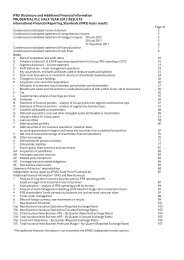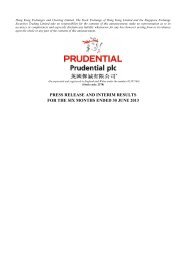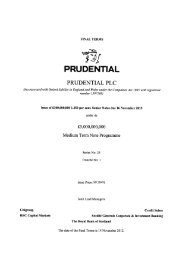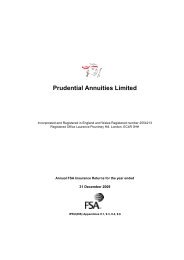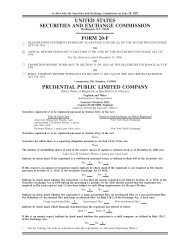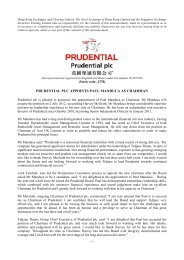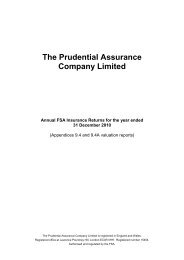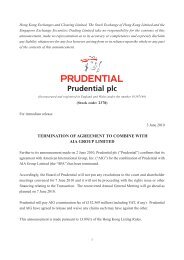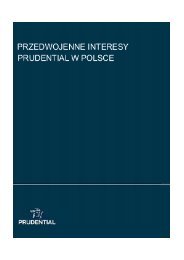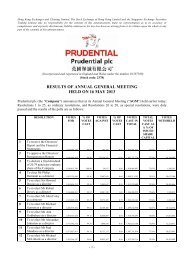ANNUAL REPORT 2001 - Prudential plc
ANNUAL REPORT 2001 - Prudential plc
ANNUAL REPORT 2001 - Prudential plc
Create successful ePaper yourself
Turn your PDF publications into a flip-book with our unique Google optimized e-Paper software.
3. Significant Accounting Policies<br />
Long-term business<br />
The results are prepared in accordance with the modified statutory basis of reporting as set out in the Statement of Recommended<br />
Practice issued by the Association of British Insurers in December 1998.<br />
Premiums and Claims<br />
Premium and annuity considerations for conventional with-profits policies and other protection-type life insurance policies are<br />
recognised when due. Premium and annuity considerations for linked policies, unitised with-profits policies and other investment-type<br />
policies are recognised when received or, in the case of unitised or unit linked policies, when units are issued. Premiums exclude any<br />
taxes or duties assessed based on premiums.<br />
Policy fees are charged to the linked, unitised with-profits and other investment-type policyholders’ account balances for mortality,<br />
asset management and policy administration. These fees are recognised as revenue when charged against the policyholders’<br />
account balances.<br />
Claims paid include maturities, annuities, surrenders and deaths. Maturity claims are recorded on the policy maturity date. Annuity<br />
claims are recorded when the annuity becomes due for payment. Surrenders are recorded when paid, and death claims are recorded<br />
when notified.<br />
Deferred acquisition costs<br />
Costs of acquiring new business, principally commissions, marketing and advertising costs and certain other costs associated with<br />
policy issuance and underwriting that are not reimbursed by policy charges are specifically identified and capitalised as deferred<br />
acquisition costs (‘DAC’). The DAC asset is amortised against margins in future revenues on the related insurance policies, to the<br />
extent that the amounts are recoverable out of the margins. Recoverability of the unamortised DAC asset is assessed at the time<br />
of policy issue, and reviewed if profit margins have declined.<br />
For with-profits business, the amortisation of the DAC asset is taken into account in determining the transfer from or to the fund for<br />
future appropriations. Movements on the DAC asset and amortisation for with-profits business have no direct impact on the profit<br />
attributable to shareholders.<br />
For single premium deferred annuity business of Jackson National Life, the determination of the expected emergence of margins,<br />
against which the amortisation profile of the DAC asset is established, is dependent on the key assumption of the expected long-term<br />
spread between the earned rate and the rate credited to policyholders. For <strong>2001</strong> the assumed rate was 1.75%.<br />
Long-term business provision<br />
<strong>Prudential</strong>’s long-term business written in the UK comprises predominantly life insurance policies under which the policyholders are<br />
entitled to participate in the profits of the long-term business supporting these policies. This business is also written in parts of Asia.<br />
Such policies are called ‘with-profits’ policies. <strong>Prudential</strong> maintains with-profits funds within the Group’s long-term business funds<br />
which segregate the assets and liabilities and accumulate the profit and loss activity related to that with-profits business. The amounts<br />
accumulated in these with-profits funds are available to provide for future policyholder benefit provisions and for bonuses to be<br />
distributed to with-profits policyholders. The bonuses, both annual and terminal, reflect the right of the with-profits policyholders<br />
to participate in the financial performance of the with-profits funds. Shareholders’ profits with respect to bonuses declared on withprofits<br />
business correspond to the shareholders’ share of the cost of bonuses as declared by the Board of directors. The shareholders’<br />
share currently represents one-ninth of the cost of bonuses declared for with-profits policies.<br />
Annual bonuses are declared and credited each year to all with-profits policies. The annual bonuses increase policy benefits and,<br />
once credited, become guaranteed. Annual bonuses are charged to the profit and loss account as a change in the long-term business<br />
provision in the year declared. Terminal bonuses are declared each year and accrued for policies scheduled to mature and death<br />
benefits expected to be paid during the next financial year. Terminal bonuses are not guaranteed and are only paid on policies that<br />
result from claims through the death of the policyholder or maturity of the policy within the period of declaration or by concession<br />
on surrender. No policyholder benefit provisions are recorded for future annual or terminal bonus declarations.<br />
The future policyholder benefit provisions on conventional with-profits and other protection-type policies are calculated using the net<br />
premium method. The net premium is calculated such that it would be sufficient at the outset of the policy to provide only for the<br />
discounted value of the original guaranteed death and maturity benefits. The provision is then calculated by subtracting the present<br />
value of future net premiums from the present value of future benefits (including vested bonuses) using a prudent discount rate. The<br />
assumptions to which the estimation of the long-term business provision is particularly sensitive are the interest rate used to discount<br />
the provision and the assumed future mortality experience of policyholders. The net premium reserves are calculated using assumptions<br />
for interest, mortality, morbidity and expense, but without assumptions for withdrawals. These assumptions are determined as prudent<br />
best estimates at the date of valuation. Interest rates used in establishing policyholder benefit provisions for conventional with-profits<br />
policies in the consolidated financial statements range from 3.0% to 5.35%. The interest rates used in establishing policyholder benefit<br />
provisions for pension annuities in the course of payment are adjusted each year and range from 5.0% to 6.0%. Mortality rates used<br />
in establishing policyholder benefit provisions are based on published mortality tables adjusted to reflect actual experience. For<br />
accumulating with-profits business of <strong>Prudential</strong> Assurance Company, the provision has been taken as the lower of:<br />
• the accumulated fund or the value at the bid price of the notional number of units allocated to policyholders, in both cases excluding<br />
terminal bonus, and<br />
• the surrender or transfer value which, having regard to policyholders’ reasonable expectations, would be payable at the valuation<br />
date,<br />
or, if greater, the value of the guaranteed liabilities excluding terminal bonus calculated on a gross premium bonus reserve method.<br />
45 <strong>Prudential</strong> <strong>plc</strong> Annual Report <strong>2001</strong>



